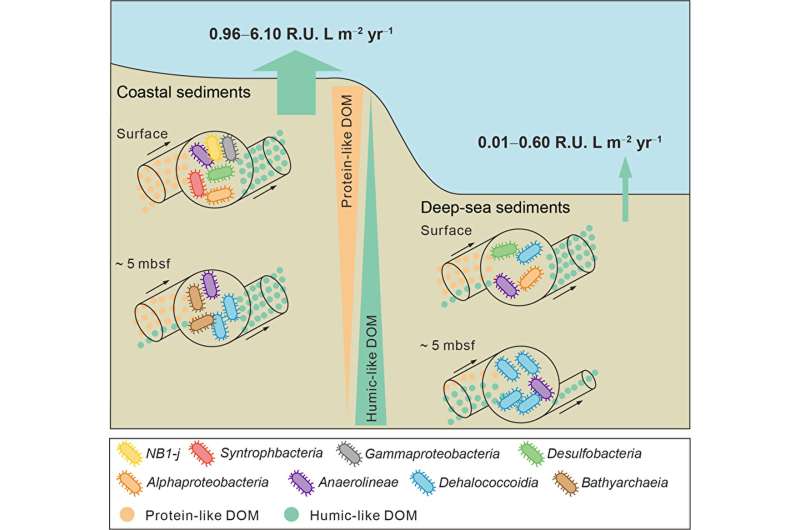Bio-reactivity of refractory humic-like dissolved organic matter found to increase in energy-limiting deep-sea sediments

Humic-like dissolved organic matter (DOM) is a major component of DOM in marine sediment pore waters. It is usually regarded as refractory for their complex molecular structures and long residence time in natural environments. However, its bio-reactivity remains poorly explored, especially in depositional settings with different organic matter availability, which makes its roles in supporting deep life and regulating long-term oceanic carbon cycling elusive.
The fluorescent DOM (FDOM), which represents a large fraction of DOM in marine sediment pore waters, was studied in 5 sediment cores recovered from the Pearl River Estuary to the deep-sea basin in the northern South China Sea. The composition of FDOM was characterized quantitatively using fluorescence techniques coupling excitation-emission matrix (EEM) measurements with the parallel factor analysis (PARAFAC) as a statistical tool. Researchers identified 6 humic-like and 2 protein-like components in the FDOM.
The fluorescence intensity of most humic-like components increased along the sediment depth, while remained consistently low for protein-like components. Therefore, humic-like and protein-like components can represent refractory and labile DOM, respectively.
The net reaction rates of these FDOM components were further estimated using a geochemical modeling method. The bio-reactivity of FDOM components was evaluated by the modeled reaction rates together with the interactions between FDOM components and microbial communities.
The researchers found that the relationships between humic-like FDOM and microbes in the coastal and deep-sea sediments were quite different. In eutrophic coastal sediments, specific microbial groups enriched in the deep layers co-varied with humic-like FDOM, while most microbial groups were significantly correlated with protein-like FDOM.
Humic-like FDOM was produced in most of the layers where protein-like FDOM was consumed, indicating the microbial transformation of protein-like DOM into humic-like DOM. On the contrary, in energy-limiting deep-sea sediments, over 70% of the microbial groups were found closely correlated with humic-like FDOM, a net consumption of which was demonstrated in deep layers.
The consumption of humic-like FDOM in deep-sea sediments reduced its total production flux in the uppermost ~5-meter layer to about one-tenth of that in coastal sediments, which could consequently decrease the refractory DOM flux to the overlying seawater. Therefore, the subsurface microbial communities may have a profound influence on the long-term oceanic carbon cycling by regulating the inventory and turnover time of refractory DOM.
The findings are published in the journal Science China Earth Sciences. The study was led by the research group of Prof. Dr. Fengping Wang from Shanghai Jiao Tong University, collaborating with Prof. Dr. Ding He from the Hong Kong University of Science and Technology and Prof. Dr. Joanna J. Waniek from Leibniz Institute for Baltic Sea Research.
More information:
Yunru Chen et al, Refractory humic-like dissolved organic matter fuels microbial communities in deep energy-limiting marine sediments, Science China Earth Sciences (2023). DOI: 10.1007/s11430-022-1123-y
Citation:
Bio-reactivity of refractory humic-like dissolved organic matter found to increase in energy-limiting deep-sea sediments (2023, July 26)
retrieved 27 July 2023
from https://phys.org/news/2023-07-bio-reactivity-refractory-humic-like-dissolved-energy-limiting.html
This document is subject to copyright. Apart from any fair dealing for the purpose of private study or research, no
part may be reproduced without the written permission. The content is provided for information purposes only.
For all the latest Science News Click Here
For the latest news and updates, follow us on Google News.

